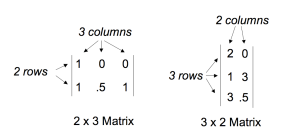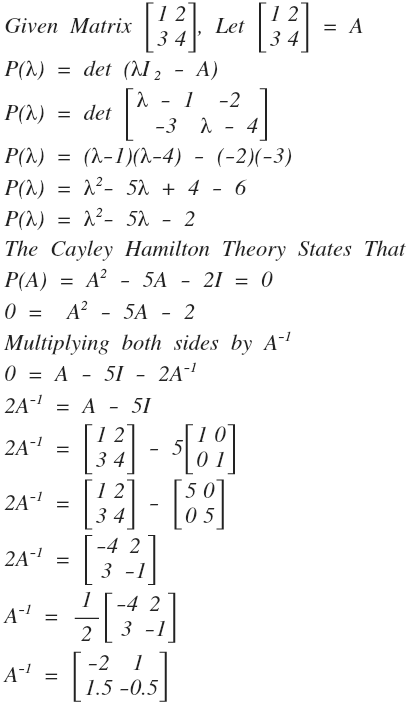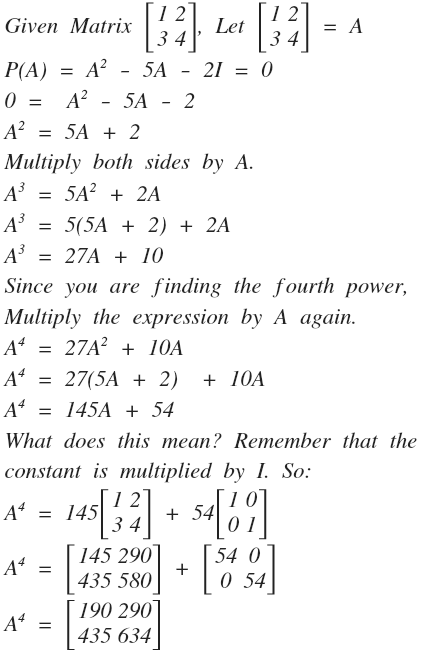As you walk in for the final math exam that determines whether you graduate high school or not, what is your greatest fear? Me being me, my greatest fear is to do with my graphing calculator and me forgetting to bring it, yes, me and my ever-so precious graphing calculator. There would be a really high chance of me failing that particular exam without my savior, and that would mean me not being able to graduate. Thankfully, that situation has not occurred to me (touches wood), and I hope that it won’t happen to you either. However, let’s assume the worst case scenario. Seeing as we are in a Data Management Class, it is nearly guaranteed that matrices are going to be part of the exam. Most likely, you will have to a) find the inverse of it or b) raise it to a fairly large power with the aid of your graphing calculator. Oh wait, that’s right, you don’t have one. Well, what do you do? Enter the Cayley-Hamilton Theorem.
Arthur Cayley and William Rowan Hamilton, two mathematicians discovered a unique feature pertaining to matrices. In case you have no clue about what matrices are, let me enlighten you. In the complex, dynamic and ever-changing world of mathematics, a matrix (plural form matrices) is a rectangular array of numbers, symbols or even expressions arranged into rows and columns. Each individual number/symbol/or expression is known as an element or an entry. A matrix with two rows and three columns is referred to as a 2 x 3 (row by column) (read as two by three) matrix. Matrices are very useful because they provide a manner in which you can organize and manage large amounts of data. Furthermore, once certain data is inputted into a matrix, it can be manipulated in a variety of manners in order to acquire different types of data or to conduct a more developed analysis on the data. The image shown directly below provides two examples of matrices, a 2 x 3 matrix and a 3 by 2 matrix.

An important thing to remember is that the Cayley-Hamilton Theorem can only be used with square matrices. What does this mean? The matrix must have the same number of columns, as it does rows. E.g. a 2 x 2 matrix is classified as a square matrix, and so is a 3 by 3 matrix. The Cayley-Hamilton Theorem (henceforth referred to as CHT) states that every square matrix satisfies its own characteristic equation. In simpler words, if A is given n x n matrix and In is the identity matrix in the form of n x n, the characteristic polynomial of A is defined as: (see image below). In this equation, the “det” refers to the determinant operation. Moreover, as the entries of matrix A are (linear or constant) polynomials in λ, the determinant is also an n-th order polynomial in λ. The Cayley-Hamilton Theorem also states that substitution for the matrix A in this very polynomial function will result in the zero matrix.
To begin with, let us attempt to derive the inverse of a two by two square matrix using the Cayley Hamilton Theorem. The first step is to define the matrix as A. Next, you must compute the characteristic polynomial, the method in which to do this differs based on the size of the matrix. Due to time constraints, this blog will only cover how to calculate the characteristic polynomial for two by two matrices. For information on how to calculate the characteristic polynomial for a three by three matrices, see: http://www.youtube.com/watch?v=FZz-Q-KBlpE. In this case, the characteristic polynomial is calculated by finding the determinant of the two by two matrix. Term A11 and A22 are subtracted by λ, and then multiplied together. That expression is then subtracted by the multiplication of the negative values of term A12 and term A21. After coming up with the characteristic polynomial, you then need to apply the CHT, and multiply both sides by A-1. From then onwards, it is a matter of isolating the inverse of matrix A.
Since we have already developed the characteristic equation for a two by two matrix, let us use the same equation and the same matrix. In this case, imagine that you have been asked to raise matrix A to the power of four. Well, you don’t have your calculator. So, what do you do? Once again, you can use the Cayley Hamilton Theorem. In this case, we are looking for matrix A raised to the power of four, meaning the end expression should be in terms of A4. Thus, we first multiply both sides by A, so that the expression is in terms of A3. Then, you must replace A2 with its expression, as defined in the working. The same steps are then repeated until the left side of the equation reads A4 and henceforth the highest degree of terms is one. Once that is done, simply recall that the constant is multiplied by the identity matrix and simplify the expression.
Once you have understood the process for two by two matrices, doing it for three by three matrices is like applying butter to bread. The process is for the most part, extremely similar. The only challenge that a three by three matrix presents pertains to developing the characteristic polynomial given a matrix. The challenge for you, as a reader is to develop that formula, as well as one for the nth by nth matrix.
Sources:
http://www.youtube.com/watch?v=uMBsABTWLI8
http://www.youtube.com/watch?v=FZz-Q-KBlpE
http://www.youtube.com/watch?v=RgQFaK28sB
http://www.youtube.com/watch?v=mn6198-LLfw
http://www.youtube.com/watch?v=1-nS-h5MRZM




Excellent work. Way beyond grade level.
It is very useful for everyone……Thank you very much.,,,,,,,
Good Afternoon,
My name is Rainer Dalhaus and I am a lecturer and professor at Heidelberg University. I approached your blog when I was pursuing supplementary material to help me better understand the Cayley-Hamilton Theorem and its Applications (the exact topic of your post). I must admit that this blog is exceptionally inclusive and detailed and have told some of my mathematically enthused students and colleagues to check your blog for updated posts on a regular basis. After seeing the comment above, may I ask; what grade are you in, and is this an assignment for a specific course or otherwise?
Thank you for your posts, they were very thought provoking.
Danke,
Rainer Dalhaus
Good Afternoon Mr. Dalhaus,
I sincerely thank you for the kind compliments, they are very much appreciated. With regards to your questions, I am in grade eleven at a Canadian High School in Hong Kong (Delia School of Canada). Yes, this is an assignment for my Data Management course at school. The goal of this assignment is to extend upon the concepts discussed in class.
I would once again like to extend my gratitude towards you and your students.
Kindest Regards,
Sahil Mohnani
good post, i have been looking for it
I am very enjoyed for this blog. Its an informative topic. It help me very much to solve some problems. Its opportunity are so fantastic and working style so speedy. I think it may be help all of you. Thanks.
Thanks for informative post. I am pleased sure this post has helped me save many hours of browsing other similar posts just to find what I was looking for. Just I want to say: Thank you!
It�s hard to find knowledgeable people on this topic, but you sound like you know what you�re talking about! Thanks
thanks.good work
really thank you very much , i didn’t understand this theorem in the lecture but , this post really help me so , thank you very very very much , keep go on
THanks a lot, I really liked your explaination
I needed some extra material regarding Cayley Hamilton in my Linear Algebra class to fill time. We did go over expressing higher powers of a matrix in terms of lower powers but then I came across finding an inverse in this manner. That was fun! Students liked it too! Thanks
By the way. Consider a 2 by 2 invertible matrix. Now you can raise the matrix to the -2 power and expressing it as a linear combination of A and identity matrix I. In fact, you can keep on going, A^-3, A^-4 etc can all be expressed as linear combinations of A and I. Even more fun!
Wow!…this is soo nice and cool!, well thanks soo much for breaking it down so well. I am actually writing my linear algebra examination tomorrow and i realised i had not studied this topic. Big thumbs up. Please keep it up.
nice sir
Pingback: Secondary School Students & Cayley-Hamilton « oafak
It is quite amazing that secondary school students have an understanding of this concept that I did not know until I was in graduate school! Congrats on this post and making it look so simple! I have taught Cayley-Hamilton theory to graduate students from the standpoint of tensor analysis and find this post quite illuminating.
Thanks very I got a better understanding on the topic now. Keep it up!!!!!
Regards Mr Daniel M
algebra examination tomorrow and i realised i had not studied this topic. Big thumbs up. Please keep it up.
this is khagesh tamada
Thank you very much. Your post was extremely helpful. You certainly explained it clearer than my teacher did 🙂
good
Hi, you post interesting posts on your website, you can get much more visitors, just search in google
for – augo’s tube traffic
Thankyou sir, for exam such as iit this is really good
That was wonderful. 🙂
Am no exception on the queue that is giving gratitude to u dear tutor.I like the way u devotedly show ua love for assisting us.